A
A-2
An excellent air hardening tool steel used by handmade knife makers and by speciality makers like Bark River as well. First maker I know of using it was Harry Morseth in the early 1930s. Performs best at about 60-61 Rc (see hardness). For many years my favorite as well as Ron Lake's. It contains about 1% Carbon, 1% Molybdenum, and 5% Chromium.
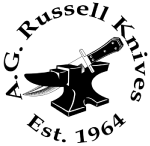
A. G. Russell Knives, Inc.
The oldest knife mail-order knife business, established in 1964. Specializes in handmade knives and high quality production knives. (see Russell, A. G.)

African Blackwood
An African Blackwood, also called Mozambique Ebony, it is a rich black with dark brown graining. Used to make fine clarinets, this is one of the very best woods for knife handles.

Alligator Clip
A clip often used on the back of ID badges, it is sometimes used for fastening small knives to the clothing.
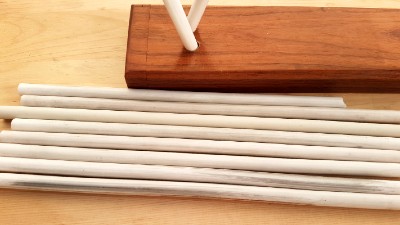 Alumina Ceramic
Alumina Ceramic
A high grade ceramic material largely made up of Alumina, very abrasive, it is extruded into rods to make up sharpening tools like A. G. Russell's™ Ceramic Sharpener. Excellent for sharpening knives as Alumina Ceramic sticks have a very high hardness and are capable of achieving a very fine finished edge. Ceramics sticks will last a long time, mostly only needing the occasional cleaning - we recommend the Rust Eraser. The rods are fairly brittle, so care must be taken. First used in this fashion by Crock Stick® inventor Louis Graves.
Amber
Fossilized pitch from pre-historic evergreens, much used in jewelry; now used by some makers of handmade knives; best known of these is D'Alton Holder.
.jpg) Amboyna Wood (also spelled Amboina)
Amboyna Wood (also spelled Amboina)
See Woods Used for Handles
Sometimes referred to as padouk, this is a rare, exotic hardwood with a fragrant aroma which varies in color from yellow to golden brown to red. It is used in cabinet making and is an excellent wood for both turning and finishing. From the Pterocarput indicus tree of the jungles of Southeast Asia. See more Knife Handle Materials here.
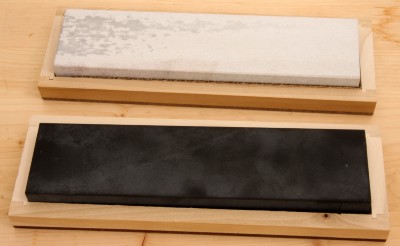 Arkansas Stone-(Novaculite)
Arkansas Stone-(Novaculite)
Discovered by Europeans about 1816, these deposits had already been a source of tools for thousands of years. Until the development of modern Alumina, the Arkansas stones were the undisputed leader in knife sharpening. The black hard will still put on a polished edge that can be obtained no other way by hand. The Washita and Soft Arkansas have largely been replaced by ceramic.
Arkansas Toothpick
Early name for Bowie knives, as the first was believed to have been made in Arkansas and the natives of that state were thought to be so tough that they picked their teeth with knives of that size. After the movie, The Iron Mistress, about 1955, it began to mean a large dagger with a needle pointed blade, very unrealistic. Some modern Arkansas makers apply the name to more sensible sized knives.
Arm knife
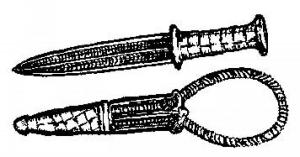
Small knives carried near the shoulder on the left arm by many tribe of the Sudanese. Double edge blade about six inches long.
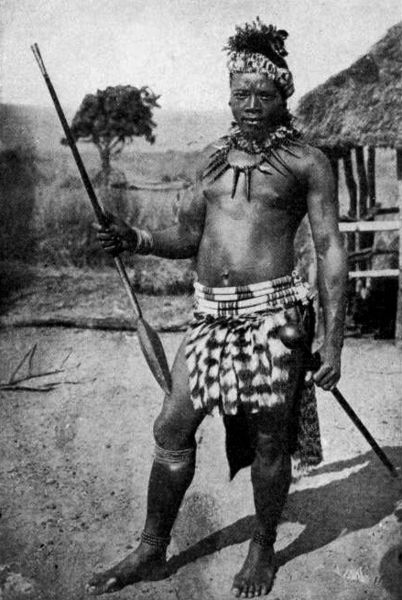 Assegai
Assegai
Portuguese word for spear, often applied to the Zulu stabbing spear. The word was never used by the natives.
ATS-34
A Japanese stainless steel, ATS-34 is a premium steel that was extremely popular with handmade makers for over 20 years. It is very comparable to American 154CM. When the quality of 154CM dipped, many handmade makers followed Bob Loveless's example and switched to ATS-34.
Carbon 1.05%, Manganese 0.40%, Chromium 14.00%, Molybdenum 4.0%, Phosphorus 0.03%, Silicon 0.35%, Sulphur 0.02%, with a typical Rockwell of 59-61 Rc.
ATS-55
Not a widely known Japanese alloy, ATS-55 is similar to ATS-34, but with the Molybdenum content reduced and new elements added.
It appears the intent was to get ATS-34 edge holding with increased toughness and decreased cost.
Carbon-1.00%, Manganese-0.50%, Chromium-14.00%,
Molybdenum-0.60%, Cobalt-0.40%
AUS-4 & AUS-6
Japanese stainless steels that are durable, stain resistant, and easy to sharpen.
AUS-4: Carbon (C) 0.40-0.45%, Chromium (Cr) 13.00-14.50%, Manganese (Mn) 1.00%, Nickel (Ni) 0.49%, Phosphorus (P) 0.04%, Silicon (Si) 1.00%, Sulphur (S) 0.03%. Typical Rockwell of 55-57 Rc.
AUS-6: Carbon (C) 0.55-0.65%, Chromium (Cr) 13.00-14.50%, Manganese (Mn) 1.00%, Nickel (Ni) 0.49%, Phosphorus (P) 0.04%, Silicon (Si) 1.00%, Sulphur (S) 0.03%, Vanadium (V) 0.10-0.25. Typical Rockwell of 55-57 Rc.
AUS-8
Excellent mid-range performance Japanese stainless steel, makes for a great work knife. Compositionally comparable to Chinese 8Cr13MoV. We've always felt AUS-8 performs much better than its elemental composition would suggest. Sometimes abreviated as 8A.
Carbon (C) 0.70-0.75%, Chromium (Cr) 13.00-14.50%, Manganese (Mn) 0.50%, Nickel (Ni) 0.49%, Phosphorus (P) 0.04%, Silicon (Si) 1.00%, Sulphur (S) 0.03%, Vanadium (V) 0.10-0.26. Typical Rockwell of 57-59 Rc.
AUS-10
Japanese stainless steel - higher grade than AUS-8.
Carbon (C) 0.95-1.10%, Chromium (Cr) 13.00-14.50%, Manganese (Mn) 0.50%, Molydenum (Mo) 0.10-0.31%, Nickel (Ni) 0.49%, Phosphorus (P) 0.04%, Silicon (Si) 1.00%, Sulphur (S) 0.03%, Vanadium (V) 0.10-0.27. Typical Rockwell of 58-60 Rc.
